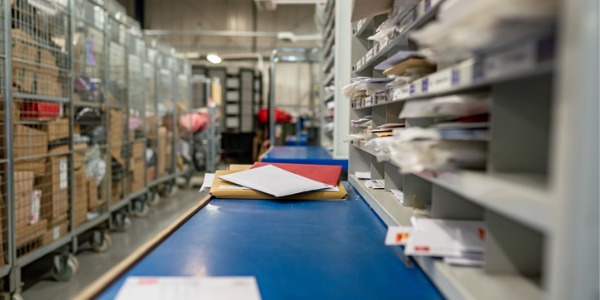What is a Mail Superintendent?
The United States Postal Service (USPS) is the federal agency responsible for mail delivery and postal services across the country. A mail superintendent in the USPS is a high-ranking official who oversees the operations of a specific mail processing and distribution center.
Mail superintendents are responsible for managing all aspects of the facility's operations, including coordinating the sorting and processing of incoming and outgoing mail, ensuring timely and accurate delivery of mail, and maintaining the overall efficiency of the center. They lead a team of supervisors, clerks, and postal workers, ensuring that each employee performs their duties effectively and in compliance with USPS regulations. This role requires a deep understanding of the USPS's policies, procedures, and safety protocols, as well as strong leadership and organizational skills to effectively manage a large-scale mail distribution center.
What does a Mail Superintendent do?

Duties and Responsibilities
The duties and responsibilities of a mail superintendent within the United States Postal Service (USPS) are multifaceted and encompass various aspects of managing a mail processing and distribution center. Here are some of the key duties and responsibilities:
- Operations Management: Overseeing the day-to-day operations of the mail processing facility, including sorting, processing, and dispatching of incoming and outgoing mail efficiently.
- Staff Supervision: Managing and supervising a team of postal workers, supervisors, and clerks to ensure they perform their duties accurately and in compliance with USPS regulations.
- Quality Control: Implementing and monitoring quality control measures to ensure the accurate sorting and processing of mail, minimizing errors, and improving overall efficiency.
- Performance Evaluation: Conducting performance evaluations and providing feedback to employees to encourage growth and productivity.
- Resource Management: Managing resources, such as equipment, supplies, and staff scheduling, to optimize productivity and control costs.
- Customer Service: Addressing customer inquiries, complaints, and issues related to mail delivery and providing satisfactory resolutions.
- Safety and Compliance: Enforcing safety protocols and ensuring compliance with USPS regulations to maintain a safe working environment.
- Process Improvement: Identifying areas for process improvement and implementing new technologies or strategies to enhance efficiency.
- Budgeting and Reporting: Participating in budget planning and providing regular reports on the center's performance and progress.
- Collaboration: Collaborating with other USPS facilities and departments to ensure smooth coordination of mail processing and delivery operations.
- Training and Development: Providing training and development opportunities to employees to enhance their skills and knowledge.
- Crisis Management: Responding to emergency situations or disruptions in mail operations and implementing contingency plans when necessary.
- Facility Maintenance: Overseeing the maintenance and cleanliness of the facility to ensure a safe and efficient work environment.
- Compliance with Postal Regulations: Ensuring that all activities within the center comply with USPS rules, regulations, and security measures.
Types of Mail Superintendents
In the United States Postal Service (USPS), there are different types of mail superintendents who oversee various aspects of mail processing and distribution operations.
- Network Distribution Center Superintendent: Network distribution centers (NDCs) serve as hubs for mail distribution, receiving and dispatching mail between different processing centers. The NDC Superintendent manages these critical nodes in the USPS network.
- Plant Operations Superintendent: Plant operations superintendents focus on overseeing the day-to-day operations of various mail processing facilities, ensuring smooth workflows, and meeting processing targets.
- Mail Transportation Superintendent: Mail transportation superintendents manage the transportation and logistics of mail between different processing centers and post offices, coordinating the movement of mail to meet delivery schedules.
- City or District Mail Superintendent: City or district mail superintendents oversee mail operations within a specific city or district, managing multiple post offices and delivery routes.
- Administrative Services Superintendent: Administrative services superintendents handle administrative functions, including budgeting, resource management, and human resources, within a mail processing or distribution center.
- Inspection Service Superintendent: Inspection service superintendents are responsible for overseeing and coordinating mail security and investigation activities to prevent fraud, theft, and other criminal activities related to mail.
What is the workplace of a Mail Superintendent like?
The workplace of a mail superintendent can vary depending on the specific type of mail facility they oversee. Generally, mail superintendents work in large mail processing and distribution centers or regional offices operated by the United States Postal Service (USPS). These facilities can be bustling, high-activity environments with numerous postal workers, clerks, and supervisors working together to process and deliver vast volumes of mail.
In these centers, mail superintendents typically have their own office space, which serves as their base for administrative tasks, meetings, and planning. This space allows them to review reports, analyze performance metrics, and communicate with higher-level USPS management. Their offices may be equipped with computers, phones, and other tools to aid in their duties.
While they have an office, mail superintendents are often highly visible on the floor, interacting with their team, observing operations, and providing hands-on support. They walk through the processing areas, distribution floors, and loading docks to ensure that mail is being sorted and dispatched efficiently. They collaborate closely with supervisors and staff to address any operational challenges and to foster a positive and productive work environment.
The work hours of a mail superintendent can be demanding, and they may need to be available outside of regular business hours to handle unexpected issues or emergencies. The nature of the USPS requires continuous mail processing, and this responsibility can sometimes extend into evenings, weekends, and even holidays.
As part of the USPS management team, mail superintendents also attend meetings and conferences, where they exchange best practices, receive updates on USPS policies, and contribute to strategic planning efforts. They work closely with other USPS managers and executives to ensure seamless coordination between different facilities and departments.